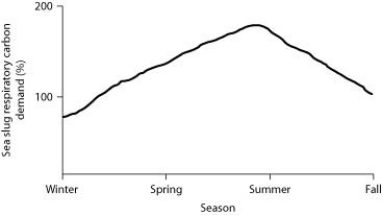Multiple Choice
The sea slug Pteraeolidia ianthina can harbour living dinoflagellates (photosynthetic protists) in its skin. These endosymbiotic dinoflagellates reproduce quickly enough to maintain their populations. Low populations do not affect the sea slugs very much, but high populations (> 5 × 105 cells/mg of sea slug protein) can promote sea slug survival. 
Percent of sea slug respiratory carbon demand provided by indwelling dinoflagellates.
-If the dinoflagellate-containing sea slug P. ianthina preys on coral animals, then it would be most surprising to find that ________.
A) P. ianthina can tolerate the toxin in the nematocysts of its prey
B) P. ianthina can locate its coral prey by chemicals released into the water by corals
C) the coral prey harbour dinoflagellates in their tissues
D) the coral prey transform themselves into medusas to flee from approaching P. ianthina
Correct Answer:

Verified
Correct Answer:
Verified
Q15: Which of the following organisms would you
Q24: Many terrestrial arthropods exchange gases with their
Q25: A primary school science teacher decided to
Q26: The nontaxonomic term sea slug encompasses a
Q31: Healthy corals are brightly coloured because they
Q33: Which of the following animal groups is
Q36: Against which hard structure do the circular
Q50: Which of the following statements is correct
Q54: One should expect to find cilia associated
Q64: Nematodes and arthropods both _.<br>A) develop an